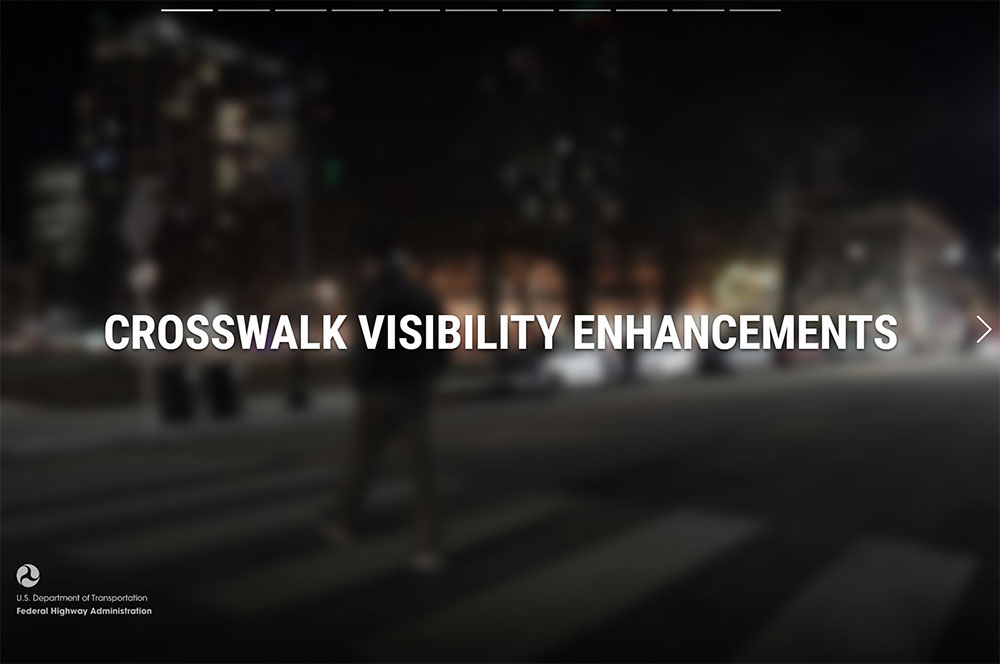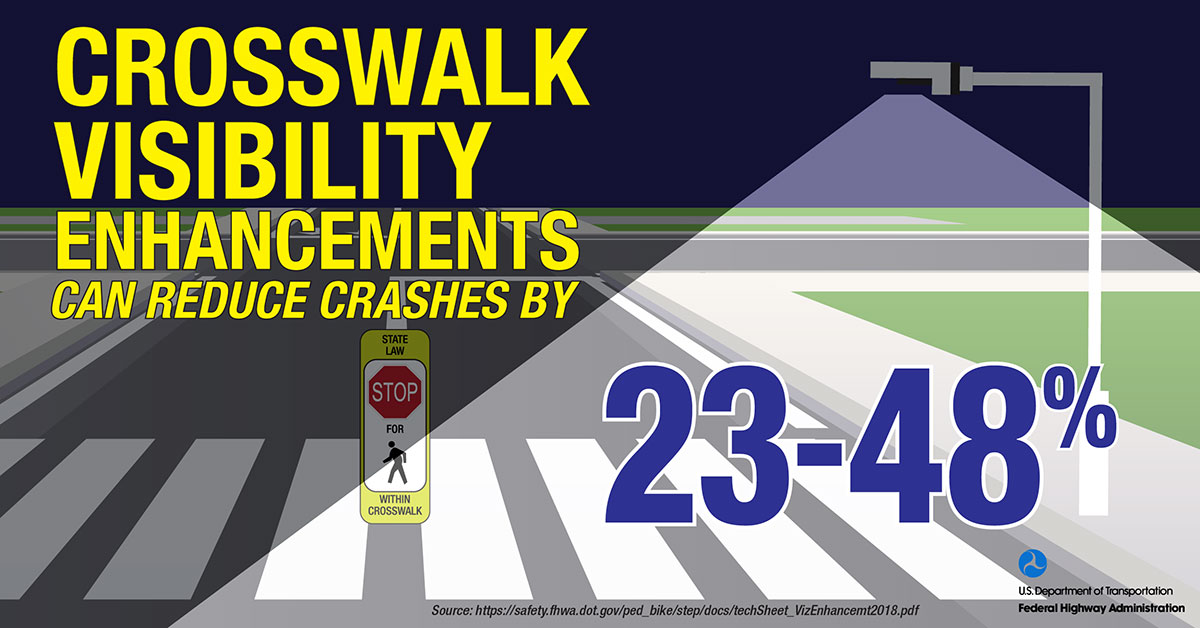May 27, 2021
Innovation of the Month:
Safe Transportation for Every Pedestrian
Over the past few weeks we’ve highlighted the Safe Transportation for Every Pedestrian (STEP) program and how local or State agencies can implement its seven featured countermeasures. For our final article in this series, we will discuss lighting and where to install it to make a difference in pedestrian safety.
In 2018, 76 percent of pedestrian fatalities nationwide occurred in dark conditions. FHWA published a video storyboard that highlights four approaches to improve pedestrian visibility at night—improving overhead lighting, installing crosswalks with high-visibility crosswalk markings, enhancing visibility with Rectangular Rapid-Flashing Beacons, and evaluating additional countermeasures like pedestrian refuge islands or other treatments.

STEP also published a summary that links to several resources explaining why improving lighting for pedestrians is important. Lighting increases the visibility of pedestrians in a crosswalk and it may even encourage more pedestrians to use a crosswalk. STEP notes that overhead lighting, when used at intersections, can reduce all types of injury crashes by 27 percent.
FHWA hosted a virtual pedestrian lighting scan tour with six Departments of Transportation (DOTs) in February of 2021. The scan tour explored conditions for improving overhead lighting for pedestrian safety and approaches agencies used to select sites and prioritize potential improvements. During the Scan Tour, Florida DOT (FDOT) shared their experiences with lighting placement. FDOT uses a data-driven method to create a funding plan allocating $100 million to retrofit over 2,500 signalized intersections throughout the State’s seven districts. As of 2020, 80 percent of the funding was spent with 350 intersections in the design phase; 1,050 intersections awaiting construction; and 750 intersections completed.
If you would like to learn more about how your agency can improve pedestrian lighting and safety with STEP, contact Becky Crowe with FHWA's Office of Safety or Peter Eun with the FHWA Resource Center.

New EDC Innovation Training Now Available On-Demand
Three online training courses are available for transportation professionals looking to learn more about designing Geosynthetic Reinforced Soil-Integrated Bridge Systems (GRS-IBS), bundling bridge projects (Project Bundling) and selecting countermeasures to help improve pedestrian safety (STEP). Designed with various expertise levels in mind and taken at your own pace, each course takes approximately 6 to 15 hours to complete depending on the selected modules. Upon completion of the course, a certificate can be printed. Register for these on-demand trainings now.
Unmanned Aerial Systems Land Surveying Changing the Way Agencies Do Business
Unmanned aerial systems (UAS) are impacting, and in some cases completely changing, many ways transportation agencies conduct business. One such area is land surveying. By using sensors that provide high-resolution images or light detection and ranging (LiDAR), or both, on small UAS, the systems enable the collection of highly accurate data with a high density of data points collected. Small UAS can use photogrammetric and LiDAR point clouds to collect more data in less time. The improved data collection capability can save costs while increasing productivity, not only by providing a better product, but also by preventing return visits to a site to collect additional data.
In the tech brief, “Use of Small Unmanned Aerial Systems for Land Surveying,” learn more about this UAS use case, including anticipated challenges, considerations to make before using UAS, and additional advantages UAS have over traditional survey methods. Learn answers to questions such as what airframe, hardware, and software may be required to collect data that provide sufficient quality to be called “survey grade.”
To learn more about UAS land surveying, contact James Gray, FHWA Office of Infrastructure, or John Haynes, FHWA Utah Division.
2021 STIC Excellence Award Nominations
Nominations are open for the 2021 State Transportation Innovation Council (STIC) Excellence Award, which recognizes a STIC that has made significant impact toward fostering a strong culture for innovation. Past awardees have been recognized for a variety of efforts and initiatives, representing agencies from across the Nation that put innovation at the forefront. FHWA and the American Association of State Highway and Transportation Officials Innovation Initiative partnered to sponsor the award to promote innovations and to recognize excellence within the STICs.
Nominations may be submitted through July 1, 2021. See the 2021 STIC Excellence Award Nomination form for more details and visit the STIC Excellence Award webpage to read about past recipients. If you have additional questions, contact Sara Lowry, National STIC Network & Incentive Program Coordinator.
Stay Up to Date on the EDC Innovations That Interest You Most
EDC teams are always on the move! If you blink, you could miss out on important webinars, case studies, tools, videos, and more. To never miss information for the EDC innovations that interest you most, visit the subscription page and select the topics you’d like to receive updates on directly from the teams that coordinate them.
Recent bulletins:
Weather Responsive Management Strategies – 5/18/21
NextGen TIM – 5/4/21
About EDC
Every Day Counts, a State-based program of the Federal Highway Administration’s Center for Accelerating Innovation, works with State, local, and private sector partners to encourage the adoption of proven technologies and innovations to shorten and enhance project delivery.
Recommended Citation:
U.S Department of Transportation, Federal Highway Administration
EDC News; May 27, 2021
Washington, DC
https://doi.org/10.21949/1521360


